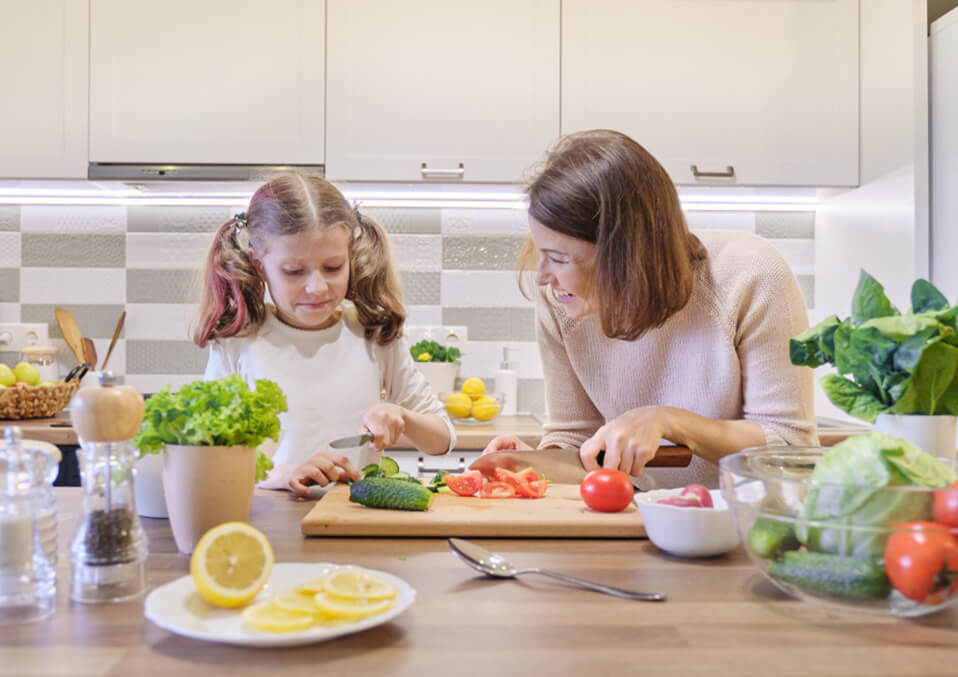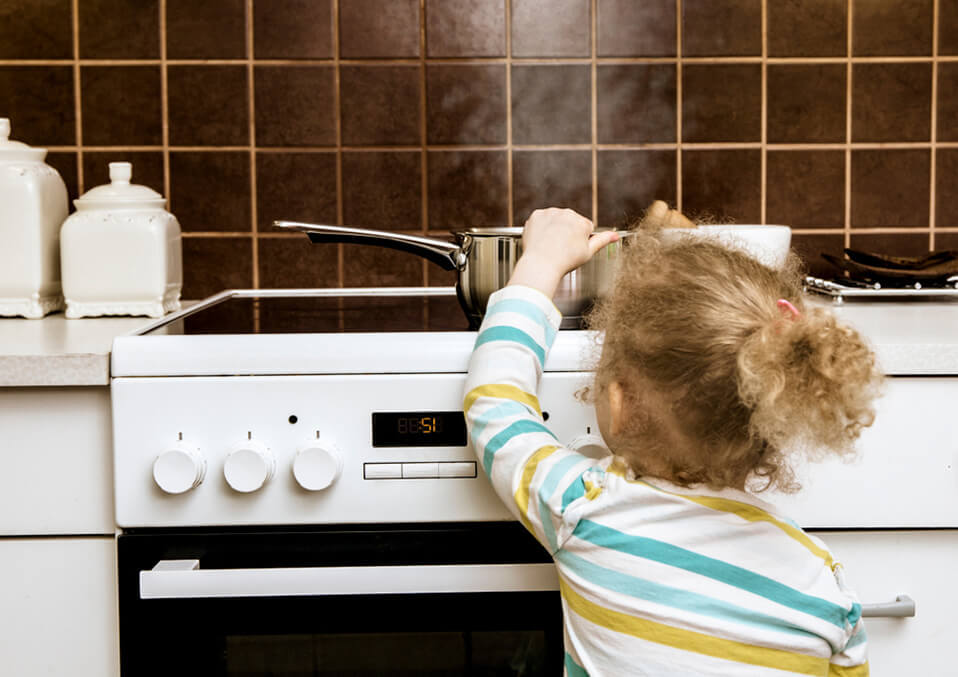
One of the often visited areas in the house is the kitchen. Not a meal will pass that a family will not going to use it. And it is not just concentrated on preparing breakfast, lunch and dinner, there are a snack and simple nibble and drink times that a family member will go or pass through the kitchen.
Food preparation in the kitchen is a time when parents and their kids can bond. They can talk about anything while busy preparing a meal. It is also important since cooking is a lifetime skill or activity that a young child should be exposed to. As you spent time in the kitchen, of course, kids will go with you. And many kids see the kitchen as another world where they can play and explore. There are much-inviting food and other items. Colors and shapes make them curious. Opening and closing kitchen drawers, the pantry or the refrigerator may bring them simple joy and excitement trying to peek what is inside. The sink is like a tiny climbing wall to test their climbing skills where the apex and the reward can be claimed once you see the top. The aroma of the food cooking makes them want to take a peek of what is on the stovetop.
A parent can be busy while in the kitchen since she is preparing some meal or maybe interrupted with calls or alarms and other sideline errands. Attention is divided then between these chores and looking after your kids while they are also in the kitchen. Better be safe than sorry. It is better to child-proof your home to prevent certain accidents in the kitchen.
Food safety

One of the basic rules inside the kitchen is food safety. It is inevitable since you will preparing and processing food that the family will later eat. Orient the kids about food safety. First, teach them to keep their hands clean. It is better to wash them in soapy waters, including that in between fingers. To make it more fun, wash while singing “Twinkle, Twinkle, and Little Star.” The entire song is said to be enough to entirely clean the hand. Rinse them thoroughly in running water. Better dry them using kitchen towels. Wet hands can be slippery.
Kitchen time is also a simple way to teach kids with segregation. Separate raw and cooked foods so as not to avoid cross-contamination. Cooked food should always be put on a clean plate or trays. Avoid putting it in used plate to avoid contamination. Discourage kids to lick their fingers while preparing the food. Especially when cooking sweets and chocolate, wow, that can be very tempting to a child. Use clean utensils in food tasting.
Show and teach them to wash kitchen utensils after using them. It is best to keep the area clean before and after food preparation.
Child-proofing the kitchen

- Keep drawers and cabinet doors close. You may bump into it which will make you lose balance and injuries.
- Install protective cushions on sharp edges and corners where your kids can bump into.
- Wipe and dry spills on the floor to prevent slip and fall. Use skid-proof rugs.
- Use sturdy stool if you are ordering your kid to reach objects or ingredients. Be the one to get those in higher counters.
- Keep kitchen towels, pot holders and curtains away from stovetop to prevent burning.
- Pot handles should be turned to the back of the stovetop. A kid’s curiosity may lead him to touch or reach for it pouring its contents to him. Be sure that handles are properly secured.
- Keep away pointed objects like knives, forks, and scissors out of children’s reach. You can invest in child-friendly peelers choppers and whisks. It will not only make them safe, but it will also stimulate interest in them.
Read also: Guidelines on talking about sex education to your kids
- Keep spices away from the child’s reach.
- Keep kids away from hot stoves and ovens. Hot oven door releases hot air when opened. Others may tend to touch their inside doors. Choose ovens that are insulated.
- Always use potholders or mittens to handle food, trays and pot handles. Doing so will teach your child to do the same. Do not let them unattended while something is cooking. Curiosity can make them try to observe what’s cooking.
- Check to be sure that all stoves and ovens are working properly. Check for leaks if they are gas-fuelled.
- Serrated edges of plastic wraps and aluminum foils can cause cuts on children. Keep them out of children’s reach.
- Check your kid’s hair and clothing while in the kitchen. It is better to tie back hair and avoid overly loose garment. Remove bracelets and necklaces. These can catch or cling on something that may cause injuries or accidents. Let the kids wear steady, comfortable footwear.
- Keep electrical cords away from the sink, stove, and oven. Don’t leave them hanging where a child can easily pull it. It may also dangle to other kitchen items or clothes. Better use cord shorteners.
- Avoid electrical shock. Don’t put electrical appliances and outlets near the sink or any water. Cover electrical sockets for safety.
- Turn off and plug off appliances when not in use. Better to keep them out of children’s reach.
Read also: 10 ways digital technology has changed parenting
- Be sure that the refrigerator and freezer doors are all secured and working well. A kid may entrap himself on large coolers. Instruct them not to do that.
- Remove too small refrigerator magnets as it may cause choking hazards. These colorful magnets are enticing to children, especially those that are designed like real food.
- Trash bags should be secured in close cabinets and secured bins.
- Keep matches and lighters about children’s reach.
- If you are going to store cleaners, disinfectants and other chemicals in the kitchen cabinet under the sink, better locked them so as not children cannot play with it that may cause them harm.
- Keep the kitchen area clean after use. I will not just be safe, it will also teach cleanliness and discipline to a child.
- Place a fire extinguisher in a strategic area.
- Know the basic first aids for cuts, burn, poisoning, shock and other common injuries kids can get in the kitchen.
Follow some kitchen rules

You can make some rules in the kitchen that children should follow. These will keep them away from certain injuries. Here are some examples:
Only grown-ups can carry and use pointed and sharp objects like knives, peelers and can openers.
Do not touch the stoves and oven covers while they are in use. Do not touch hot trays, pans, and hot foods unless approved by an adult.
Wash hands again if you touched raw ingredients, especially meat, poultry, and fish.
Always ask for an adult’s help or assistance when needed.
Always supervise the kids when they are in the kitchen and make it a safe place for them. But don’t just make your kitchen safe. Let it be a place for learning and fun. Talk and bond with the kids! Cooking with your child doesn’t only create skills, it also creates a memory. But always be sure that all of those memories are unforgettable not because it causes accidents or injuries. Make sure safety always comes first. Make memories that you and your child will remember even as they grow up – memories of love and care, happiness and cheer.
Read also:
- Kids and Safety the Sooner, the Better
- Easy Ways on How to Make a Tent for Kids
- The Recommended Summer Education Programs For Kids


